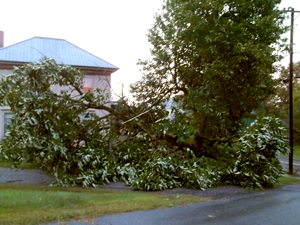

by Tena Starr
ORLEANS — The heavy rain and wind that hit northern Vermont last week had an unusual victim: the magnolia tree that has, for some reason, been thriving in Orleans for nearly 60 years.
Magnolias don’t generally overwinter in far northern Vermont — they barely manage in southern Vermont. But apparently someone forgot to tell this particular tree it was not supposed to survive an Orleans County winter.
Kimberly Campbell said the storm took down a section of the tree, the part her family called the rope swing branch.
“I heard this big cracking sound and turned just in time to see the tree go down,” Ms. Campbell said. “It had ripped the power box from the side of the house.”
She’d initially hoped the rest of the tree would survive, but the crew who cut up the felled section noticed it was infected with parasites, weakening the whole thing.
Sadly, the rest of it will have to be cut as well, Ms. Campbell said. If it fell, it would take out the power lines for the neighborhood, she said.
Ms. Campbell, who bought the house where the magnolia is in 2007, said she’s learned more about it in the past week than she ever knew before. People have dropped by to tell her stories about the tree, which UVM’s horticulture department has been following for years. “They’re going to try as hard as they can to grow one,” she said.
The species is Magnolia acuminata, or in common language, a cucumber tree magnolia.
It’s quite rare, especially this far north, said Mark Starrett, an associate professor at the University of Vermont. It’s one of the parents of several modern types of yellow-flowered magnolias that have been hybridized and are now widely available, he said.
Its rarity is due to the fact that when it was planted in Orleans the climate was colder, with more severe winters, and it was thus less likely to survive, Mr. Starrett said. Also, it’s not a particularly showy tree, and he suspects that 60 years ago Vermonters weren’t all that prone to trying to grow exotic plants.
He said he’ll try to propagate plants from seeds from the Orleans tree. Any seedlings that result will be distributed around Vermont, he said. Some will stay on the UVM campus and others will be distributed through the Vermont Hardy Plant Club.
Norman Pellett came to UVM in 1967 as Extension ornamental horticulturist, and made frequent trips around the state advising nurseries and greenhouse operators, landscape architects and technical school program teachers. Through that work, he ran across a variety of uncommon plants in Vermont, he said.
The only other big cucumber magnolia he’s seen is in Rutland, although others might exist, he said.
Irene Lanoue, who still lives in Orleans, said her late husband, Rouville, planted the tree two or three years after they got married in 1953.
“He sent away to the Michigan Bulb Company for it,” she said. “I don’t know how he picked it out. I can’t remember how he came to order that tree.”
In any event, once it started growing, he was curious about what it was, Mrs. Lanoue said. “He planted it and it started growing. It wasn’t supposed to.”
But the Lanoues didn’t learn that until later, when her husband contacted UVM to ask about what he had. “He wrote to the Extension Service at UVM and they sent up a man to look at it.”
Steve Matthews was a paperboy for the Lanoues at the time the tree was planted. “I knew it was a magnolia tree, and it wasn’t supposed to be growing here,” he said.
He’s kept up with the tree throughout its lifetime and on Sunday picked up some of its pods from the brush that remained on the ground, and sent them to Mr. Starrett.
“We’ll see if we can get some seeds from it that might be able to germinate,” he said.
He said he doesn’t think that’s likely with the seeds he picked up, but he hopes something will work out so a species of the exceptionally cold hardy Orleans magnolia can be propagated.
Ms. Campbell said the tree wasn’t showy like the magnolias in the South. It had huge leaves, she said.
“They looked like great big elephant ears. They’re huge and sprouted at the end of the leaf you see kind of these longish pink things.”
It had a lemon peppery smell, Ms. Campbell said. “It’s been a great shade tree,” she said.
Mrs. Lanoue said she regularly walks by her old home and checks on the magnolia. It will be sad when it’s gone, she said.
contact Tena Starr at [email protected]
For more free articles from the Chronicle like this one, see our Featuring pages. For all the Chronicle’s stories, pick up a print copy or subscribe, either for print or digital editions.







